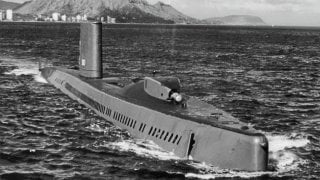USS Halibut: The Navy's Secret Spy Submarine That Salvaged a Downed Russian Sub
Just the second U.S. Navy vessel to be named after the halibut species of fish, SSN-587, or USS Halibut, has the distinction of earning two presidential citations, two Navy Unit Commendations, and the Navy E Ribbon. The boat and her crew were noted for taking part in a series of operations that could be described as something out of a Tom Clancy novel – and we likely only some of the exploits carried about by the submarine.
Just the second U.S. Navy vessel to be named after the halibut species of fish, SSN-587, or USS Halibut, has the distinction of earning two presidential citations, two Navy Unit Commendations, and the Navy E Ribbon. The boat and her crew were noted for taking part in a series of operations that could be described as something out of a Tom Clancy novel – and we likely only some of the exploits carried about by the submarine.
In fact, the story of USS Halibut is unique in that the boat was actually the first to be designed and subsequently "built from the keel up to launch guided missiles," NavySite reported. "Designated SSGN 587 and intended to carry the Regulus I missile, she was equipped with a retractable ramp used to launch the missiles and with a special shelter capable of storing up to four Regulus I or two Regulus II missiles."
As previously reported by The National Interest, "The missile was designed to be launched from the deck of a submarine, with a ramp leading down into the bow of the ship, where a total of five missiles were stored. This resulted in an unusual appearance, likened to a 'snake digesting a big meal.' Halibut also had six 533-millimeter torpedo tubes, but as a missile sub, would only use torpedoes in self-defense."
Moreover, USS Halibut was described as "a one-of-a-kind submarine. At 350 feet long, with a beam of twenty-nine feet, she was dimensionally identical to the Sailfish-class radar picket submarines, but her missile storage spaces and launch equipment ballooned her submerged displacement to five thousand tons. Her S3W reactor gave her an underwater speed of more than twenty knots and unlimited rangea useful trait, considering the Regulus II had a range of only one thousand miles."
After the suspension of the Regulus program, in 1965 USS Halibut was reclassified by the U.S. Navy as a nuclear-powered attack submarine.
Deep Submergence Group
If that had been all that SSN-587 accomplished was being the first guided-missile boat, the submarine would still have earned a place in the history of the "Silent Service," but the USS Halibut was modified and in the spring of 1966 began service with the Deep Submergence Group, which was tasked with deep sea search and recovery missions.
That included a very covert mission in July 1968, when USS Halibut was charged with locating the Soviet Navy's Golf II missile submarine K-129, which had sunk under mysterious circumstances in waters reported to be as create three miles deep. For her role in "Operation Sand Dollar," which successfully located the Soviet submarine after more than three weeks of searching, President Lyndon Johnson awarded the SSN-587 the Presidential Unit Citation (PUC), the highest submarine award possible.
Thanks to the efforts of USS Halibut in locating and photographing the Soviet submarine, in 1974 President Nixon gave the green light for CIA's "Project Azorian," which used the specially designed "Glomar Explorer" drillship built by Howard Hugh's Global Marine to secretly salvage the K-129.
Ivy Bells
In early 1970, USS Halibut "underwent further modifications to accommodate a special group of saturation divers using methods pioneered at SeaLab. This 'Special Projects' boat was now a part of Submarine Development Group One" and it went on to take part in "one of the most critical spy operations undertaken by submarines during the cold war," explained AboutSubs.com.
The submarine was tasked with locating and then tapping the "underwater communications cable that ran from the Soviet missile submarine base at Petropavlovsk, on the Kamchatka peninsula, under the Sea of Okhost, to Fleet headquarters near Vladivostok."
It would be a colossal understatement to suggest it was harder than sounds. Divers had to exit the submarine while tethered with special cords that pumped warm water into their suits. In the cold dark water, the divers searched the ocean floor and successfully found the Soviet cables.
According to Military.com, the divers then "installed a 20-foot-long listening device on it. Designed to attach to the cable without piercing the casing, the device recorded all communications that occurred. If the cable malfunctioned and the Soviets raised it for repair, the bug, by design, would fall to the bottom of the ocean. Each month, Navy divers retrieved the recordings and installed a new set of tapes."
Each of the tapes made their way to the National Security Agency (NSA), which analyzed the recordings and deciphered any encrypted information. However, perhaps not believing anyone could tap the lines, most of the communications traveled through the cables with little to no encryption.
Following the successful completion of the "Ivy Bells" mission, USS Halibut was awarded the Navy Unit Citation and later for repeated operations in the Sea of Okhost, SSN-587 received its second President Unit Citation. The boat would go on to earn two additional NUCs.
While the U.S. continued to listen in on the Soviet communications for several more years, USS Halibut was decommissioned on November 1, 1975, after 1,232 dives and more than 16 years of service.
It wasn't until 1981 that the Soviets dispatched a salvage ship to remove the tap. U.S. counterintelligence later found that it was an NSA employee – Ronald Pelton – who sold out the program to Moscow for $35,000. Though he was sentenced to life in prison, he was paroled in 2015 and died seven years later. The original tap is now reported to be on display at the KGB Museum in Moscow.


